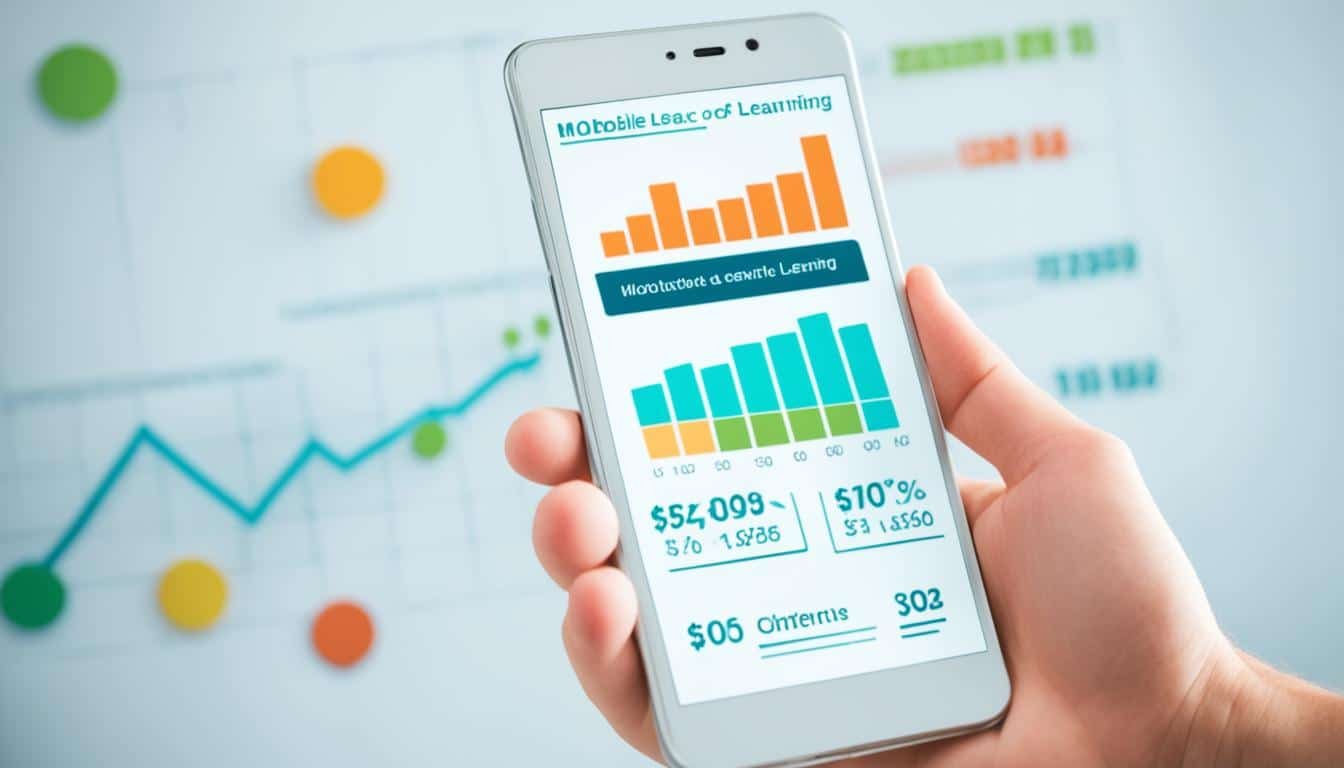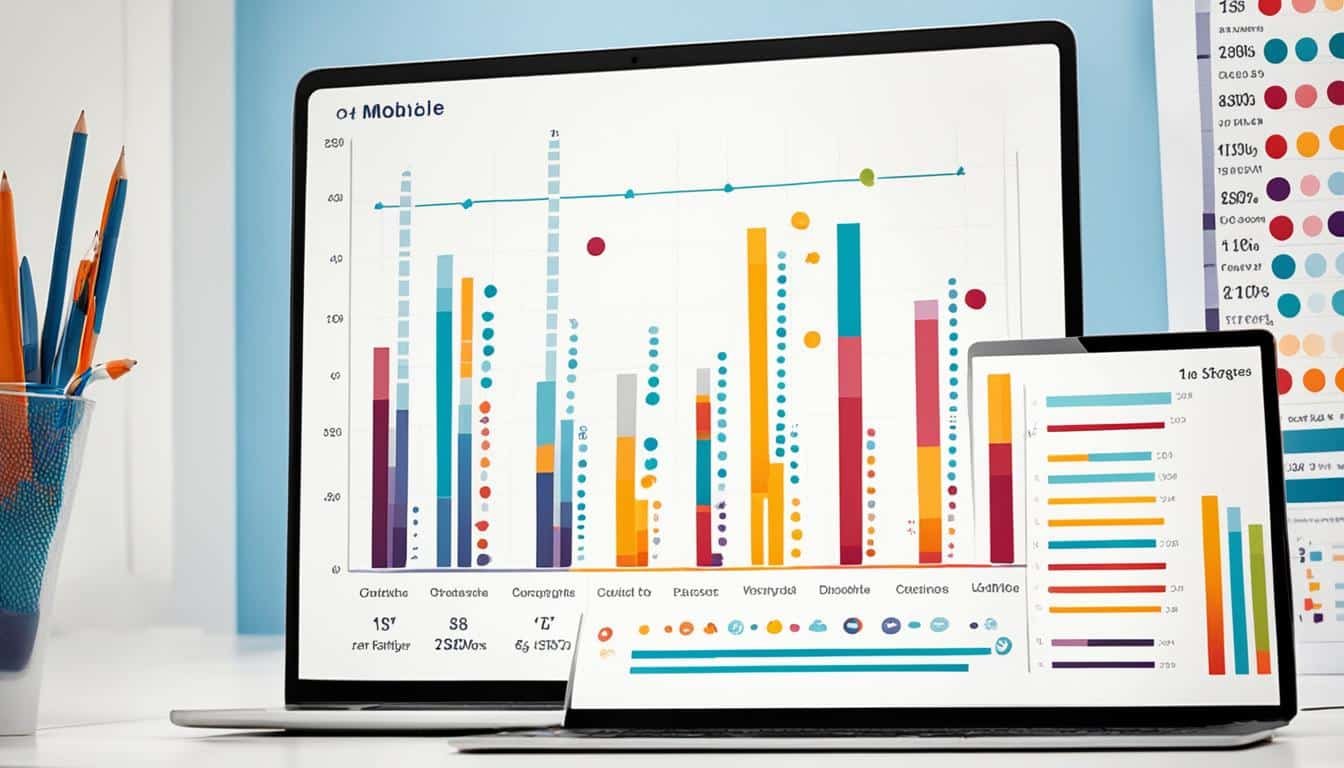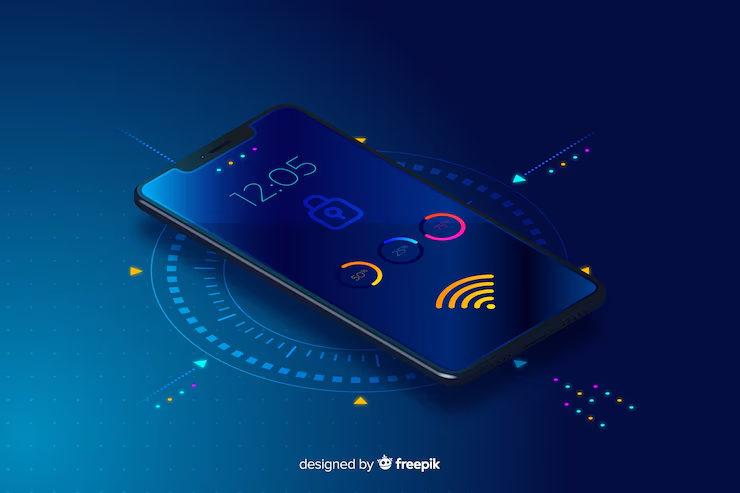Mobile technology has changed how we live, work, and learn. Smartphones and tablets are now key in education and training. This is known as mobile learning, or mLearning. It lets learners get to educational materials and learn from anywhere, anytime.
This type of learning is flexible and convenient. It makes learning more engaging and accessible. It also saves money and helps learners work together better.
Key Takeaways
- Mobile technology has changed education, making mobile learning possible with many benefits.
- Students can now learn anytime, anywhere with mobile devices.
- Mobile learning offers convenience, flexibility, and better engagement for students.
- It makes learning available to more people, promoting inclusive education.
- Mobile solutions are often cheaper than traditional learning methods.
Embracing Mobile Learning
The COVID-19 pandemic made mobile learning more important. Most people own mobile devices and have internet access. This lets mobile learning be a good way to teach and learn. Mobile learning lets learners study and do activities anywhere, using devices like smartphones, tablets, and laptops.
Widespread Use of Mobile Devices
This mobility and flexibility fit well with learning styles that focus on the learner. Because so many have mobile devices and wireless networks, mLearning is now a big part of school.
“The ubiquity of mobile devices and wireless networks has paved the way for mLearning to become an integral part of the educational landscape.”
Teachers are using mobile learning to make learning flexible and accessible. They use portable computing devices to meet the different needs and likes of their students.
Convenience and Flexibility
Mobile learning offers huge benefits in terms of convenience and flexibility. With mobile devices, learners can access educational materials and learn anytime, anywhere. This lets students fit learning into their busy lives, studying at their own pace.
Mobile devices make learning easy to do outside the classroom. Students can use their smartphones or tablets during downtime, like when they’re commuting or waiting in line. This way, they can learn whenever it’s convenient for them.
“Mobile learning allows me to fit education into my daily life. I can review course materials on my commute or squeeze in a quick study session while waiting for an appointment. It’s a game-changer for busy professionals like myself.”
Mobile learning is versatile, fitting different learning styles and needs. Students can read, watch videos, or do interactive activities on their devices. This makes learning more personal and flexible.
By using mobile learning, students can control their learning journey. This leads to better learning outcomes and a more rewarding educational experience.
Improved Engagement

Mobile learning makes learning more interactive and personalized. It uses gamification, simulations, and multimedia to keep students interested and motivated. This leads to better retention of information and a more fun learning experience.
With mobile devices, teachers can tailor learning to each student’s needs. This personalization makes students more engaged. They feel more connected to the material and can learn at their own speed.
Gamification and simulations make learning fun and engaging. They turn the learning process into an exciting adventure. This approach boosts student motivation and helps them remember important concepts better.
Using multimedia like videos, animations, and visuals also increases student engagement. These tools make hard topics easier to understand and more interesting. This leads to a deeper grasp of the subject.
Adding mobile learning to education can greatly improve student engagement. It leads to better learning outcomes and a more positive learning experience for students of all ages.
| Feature | Impact on Student Engagement |
|---|---|
| Gamification | Transforms learning into a fun and immersive experience, enhancing motivation and retention. |
| Simulations | Provides interactive and engaging activities that reinforce key concepts. |
| Interactive Multimedia | Makes complex topics more accessible and engaging, fostering deeper understanding. |
| Personalized Learning | Caters to the unique needs and preferences of each student, increasing investment and engagement. |
“Mobile learning has the power to transform the educational landscape, driving increased student engagement and a more enjoyable learning experience.”
Increased Accessibility

Mobile learning makes education more accessible, especially for those who can’t get to traditional classrooms. The COVID-19 pandemic showed how hard it is to give everyone equal access to online learning. But, mobile learning can fill this gap. With more people using mobile devices and internet, it can bring education to places that don’t have it.
Reaching Underserved Communities
In many places, including the U.S., some communities have always struggled to get good education. Mobile learning can change this. It uses mobile devices and online instruction to make sure everyone has the same chance to learn. This means people in remote or underserved areas can learn just like others do.
“Mobile learning has the potential to revolutionize education, particularly for those who have been marginalized or underserved in the past. It’s a powerful tool for driving equity and providing access to quality learning opportunities.”
Mobile learning uses the wide use of mobile devices and better connectivity in remote areas. This opens new ways for people to learn and get skills. It helps them overcome disadvantage and work towards a more equal future.
Cost-Effectiveness

Mobile learning can be more cost-effective than traditional classroom learning. It cuts down on the need for classrooms, instructors, and materials. This means big savings for schools and businesses.
The cost of devices is going down, making mobile learning cheaper for everyone. This change lets schools and companies use their money better. They can focus on making great content and giving students personalized learning experiences instead of just keeping up buildings.
- Reduced costs associated with physical classrooms
- Decreased expenses for instructors and materials
- Affordable access to mobile devices and mobile learning platforms
- Efficient resource allocation, prioritizing content and personalized learning
“The cost savings associated with mobile learning can be a game-changer for educational institutions and businesses, allowing them to redirect funds towards more impactful initiatives.”
As devices get cheaper, mobile learning is becoming a top choice for quality education and training. This move to cheaper and more flexible learning can really open up more learning chances. It also brings new ideas to the classroom and workplace.
Mobile Technology
Mobile technology, like smartphones, tablets, and laptops, is key for mobile learning. These devices are easy to carry and work well with wireless networks and internet connectivity. This makes learning on the go possible. But, not everyone has the same access to these devices and reliable connectivity. This can affect how well mobile learning works.
Mobile technology makes learning easy and flexible. Students can get to educational content, work with friends, and do learning tasks anywhere, anytime. This is great for students who can’t get to school often or need learning that fits their needs.
Also, mobile technology makes learning more fun. It uses interactive and rich content, makes learning a game, and gives feedback right away. This keeps students interested and helps them do better in school.
| Mobile Device | Advantages in Education |
|---|---|
| Smartphones | Ubiquitous access, on-the-go learning, camera and video capabilities, educational apps |
| Tablets | Portable, touch-based interaction, enhanced multimedia and digital textbook experiences |
| Laptops | Powerful computing, productivity tools, integration with classroom technology, note-taking |
But, using mobile technology in schools also has its challenges. We need to make sure all students can use mobile devices and have good connectivity. This is important for fair learning chances for everyone.
“Mobile technology has the potential to revolutionize education, but its true impact will depend on how we address the challenges of access and equity.”
Collaboration and Community

Mobile learning is more than just studying alone. It helps students work together better. With tools like discussion boards, instant messaging, and group projects, students can talk and work together in real time. This creates a strong community feeling, even if they’re far apart.
Mobile learning makes students talk to each other, share ideas, and do group work. Discussion boards let them ask questions, share thoughts, and get feedback right away. Instant messaging lets them chat, brainstorm, and work on group projects easily.
This way, students feel closer to their classmates and teachers. It makes learning more engaging, helps them understand better, and makes them feel they belong in the mobile learning world.
Despite these advancements, there are still challenges that need to be addressed, such as security and privacy concerns. However, the advantages of mobile technology are undeniable, as they provide information and communication technologies that are used in a variety of sectors. The fourth generation of cellular technology (4G) laid the groundwork for the innovations of 5G, which is expected to reach unprecedented speeds and capabilities.
mobile devices to share mobile device management and mobile device management and mobile application information technology technology also powerful mobile 5g is the fifth generation networks that connect these devices hardware and software user to access sending and receiving within the app packet switching technology.
Real-Time Communication
Mobile learning is great for talking to others in real time. With tools like discussion boards and instant messaging, students can chat, share ideas, and get quick feedback from anywhere.
- Discussion boards let students ask questions, share thoughts, and get answers from others and teachers right away.
- Instant messaging lets them have quick chats, brainstorm, and work together on projects.
- Mobile learning makes students more active and connected, building a strong community feeling.
This way of talking and working together makes learning better. It leads to more engagement, deeper understanding, and a sense of belonging in the mobile learning world.
| Feature | Benefit |
|---|---|
| Discussion Boards | Facilitate real-time conversations, exchange of ideas, and peer feedback |
| Instant Messaging | Enable spontaneous collaboration and problem-solving among students |
| Group Projects | Promote teamwork, communication, and a sense of community |
Teaching Specific Skills
Mobile learning is now key for teachers to give students the skills they need for their future jobs. It lets teachers use mobile tech to make learning fun and interactive. This way, students can learn complex ideas and skills easily.
Mobile learning lets students get familiar with the digital tools they’ll use at work. This gives them an edge in the job market. It offers simulations and interactive settings for learning many professional skills.
Mobile technologies enable global positioning systems (GPS), multimedia messaging service (MMS), and seamless integration with application programming interfaces (APIs). The development of mobile technologies has led to various forms of mobile devices, from personal digital assistants to smartphones, allowing users to connect devices to the internet and share data effortlessly.
It’s also great for teaching digital skills, which are vital today. Students learn to use software, apps, and digital tools. This helps them be confident and skilled in the digital world.
| Skill | Benefits of Mobile Learning |
|---|---|
| Digital Skills | Exposure to various software, apps, and digital platforms to develop proficiency |
| Professional Skills | Simulation-based training to practice real-world scenarios and problem-solving |
| Collaboration | Interactive environments that foster teamwork and communication |
Mobile learning gives students an edge by teaching them the skills and tech they’ll need in their careers. It boosts their career readiness and prepares a workforce ready for the digital age.
Mobile technology has become a cornerstone of modern communication and computing, revolutionizing how users interact with the world. Mobile devices such as smartphones and tablets facilitate mobile computing, enabling internet access and the use of mobile applications for information and entertainment. With advancements from 1G to 5G, the latter being the fifth generation of cellular technology, smartphone users can now experience internet speeds 100 times faster than 3G.
Mobile payment systems and enterprise mobility management have transformed commerce and business operations, while mobile device management (MDM) and mobile application management (MAM) are essential for securing and managing devices in corporate environments. Technologies like packet switching and short-wavelength radio waves have enhanced mobile communications, making wireless technologies more robust and reliable.
Analytics for Learning

Mobile learning makes learning easy and flexible for students. It also helps teachers collect and analyze important data. This data helps teachers understand how students are doing, what they like, and what they need to learn better.
Teachers use mobile tech to get real-time data on students. This lets them see how well students are doing, how interested they are, and what they’ve learned. This approach helps teachers make better choices about how to teach, give feedback to students, and change their lessons to fit what students need.
The productivity of these devices is further enhanced by the use of hotspots and short message service (SMS), providing two-way communication and connectivity. The transition from 3G and 4G to the fifth generation (5G) has significantly boosted frequency and speed, supporting a wide range of applications on tablets and other devices and apps. As cell towers proliferate, the generation of cellular technology continues to advance, driving the next wave of wireless innovations that allow users to compute, communicate, and connect like never before mobile devices and apps text message advancement api smartphone type of mobile.
Data-Driven Insights
Mobile learning analytics give us deep insights into how students learn best. Teachers can see where students are having trouble and change their teaching to help. Formative assessment tools on mobile platforms give feedback quickly, helping students see their progress and teachers adjust their teaching.
Mobile devices also help us understand how students learn and what they like. Teachers can use this info to make learning more personal. They can give feedback and advice that fits each student’s needs. This makes learning better and more engaging for students.
| Benefits of Mobile Learning Analytics | Description |
|---|---|
| Improved Monitoring | Mobile devices let teachers track students’ progress and interest in real time. This gives teachers important data to meet students’ learning needs. |
| Personalized Feedback | Analytics help teachers give feedback that fits each student, making learning better for everyone. |
| Adaptive Instruction | Data from mobile learning helps teachers adjust lessons to match what students need and know. |
| Improved Outcomes | Using mobile learning analytics can make students more engaged, retain more information, and do better in school. |
By using mobile learning analytics, teachers can get lots of data-driven insights. These insights can change how we learn and help students succeed.
With the advent of 5G and the continuous evolution of mobile technology, smartphones and mobile devices have become integral to modern life. These mobile apps and mobile applications run on sophisticated operating systems and connect to mobile networks and wifi networks, leveraging cellular service and wi-fi for seamless wireless communication. The internet of things (IoT), powered by artificial intelligence and machine learning, has expanded the capabilities of mobile phones, enabling augmented reality and virtual reality experiences. Mobile security is a critical aspect as users navigate through cloud-based services and APIs, ensuring safe transmission of data through cellular networks and radio waves.
Efficiency
Mobile learning makes learning easy and flexible. Teachers use it to help students move through content quickly. This gives students more time to think deeply and analyze.
Mobile learning also helps with time management. It makes learning more efficient for teachers and students. By accessing learning materials anywhere, learners use their time well, even during short breaks.
This way of learning lets learners control their learning. They can focus on what they need, making learning more effective. This leads to better understanding and retention of the material, boosting productivity and learning success.
“The convenience and flexibility of mobile learning can contribute to better time management and overall productivity for both instructors and learners.”
Using mobile learning, teachers can deliver content better. It helps learners think more deeply and manage their time well. This makes learning more efficient for everyone.
Also Read : What Are The Main Types Of Machine Learning?
Conclusion
Mobile technology has changed education in big ways. It brings many benefits that make learning better for students and teachers. These devices are convenient, flexible, and make learning more engaging and accessible.
More people own mobile devices, which means more chances for mobile tech to change education. It helps students work together, learn new skills, and gives teachers insights with analytics. This tech is getting students ready for the digital world and helping teachers teach in new ways.
Using mobile technology in schools can change how we learn. It lets students take charge of their learning and teachers share content in new ways. By using mobile learning, education can keep up with the needs of today’s students.
FAQs
Q: What are the benefits of using mobile technology in education?
A: Mobile technology in education provides access to a wealth of resources, enhances collaboration between students and teachers, promotes interactive learning, improves communication, and enables personalized educational experiences.
Q: How can mobile apps enhance the learning experience?
A: Mobile apps can offer a wide range of educational tools such as interactive lessons, virtual simulations, study aids, and digital textbooks, making learning more engaging and accessible anytime, anywhere.
Q: What role does mobile technology play in the development of students’ skills?
A: Mobile technology helps students develop crucial skills such as problem-solving, critical thinking, digital literacy, creativity, and adaptability, preparing them for success in the digital age.
Q: How can mobile technology support remote learning?
A: Mobile technology enables remote learning by providing online access to educational materials, facilitating communication between students and instructors, and offering virtual classrooms and collaboration tools.
Q: What are the security considerations when using mobile technology in education?
A: Security measures such as data encryption, user authentication, regular updates, and secure network connections are essential to protect students’ personal information and ensure a safe learning environment when using mobile technology in education.
Q: How does mobile technology contribute to a more personalized learning experience?
A: Mobile technology allows for adaptive learning pathways, personalized feedback, customized content delivery, and individualized instruction based on students’ learning styles and preferences, enhancing the overall learning experience.
Q: What are some challenges associated with integrating mobile technology in education?
A: Challenges may include infrastructure limitations, device compatibility issues, digital divide concerns, potential distractions, security risks, technology integration barriers, and the need for proper teacher training to effectively leverage mobile technology in educational settings.
